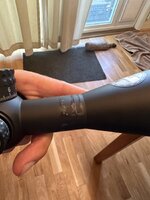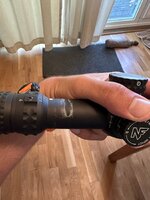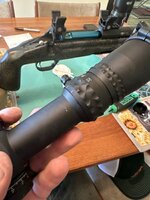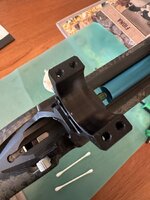Navigation
Install the app
How to install the app on iOS
Follow along with the video below to see how to install our site as a web app on your home screen.
Note: This feature may not be available in some browsers.
More options
Style variation
You are using an out of date browser. It may not display this or other websites correctly.
You should upgrade or use an alternative browser.
You should upgrade or use an alternative browser.
scope slipping
- Thread starter Coxen02
- Start date
fwafwow
WKR
- Joined
- Apr 8, 2018
- Messages
- 6,093
Pictures may help.
RockAndSage
WKR
Even if those rings were absolutely, perfectly milled out of one piece of stock, together, on an extremely precise machine...they were not done so out of the same solid piece as that rifle's receiver or its rail. There will be variances in perfection between each ring and where it's mating up with the rail or action. They can be perfect to each other coming out of Hawkins - and instantly won't be perfect to each other once you put them on the gun.
There's nothing wrong with the rings, or the gun, in all likelihood. To expect that level of perfection between all those differently machined parts and how they mate up is simply not reasonable - especially when every single piece, including the scope, is coming out of different shops.
You'll quickly see just how much of the scope ring material was not in contact with the scope once you lap.
People need to quit fighting lapping and just do it. It's cheap, and incredibly revealing after you've done it even one time.
There's nothing wrong with the rings, or the gun, in all likelihood. To expect that level of perfection between all those differently machined parts and how they mate up is simply not reasonable - especially when every single piece, including the scope, is coming out of different shops.
You'll quickly see just how much of the scope ring material was not in contact with the scope once you lap.
People need to quit fighting lapping and just do it. It's cheap, and incredibly revealing after you've done it even one time.
I have a whole kit and I've done it before but then switched most of my rifles out to rail systems and haven't bothered thinking the rail systems should be pretty darn straight and consistent. I'm curious if others find value in lapping them as well? So far I've not had any issues that I know of.People need to quit fighting lapping and just do it. It's cheap, and incredibly revealing after you've done it even one time.
RockAndSage
WKR
I have a whole kit and I've done it before but then switched most of my rifles out to rail systems and haven't bothered thinking the rail systems should be pretty darn straight and consistent. I'm curious if others find value in lapping them as well? So far I've not had any issues that I know of.
My personal experience thus far has been that the mounts which need the least amount of lapping have been the high-quality 1-piece mounts for pic rails - ones milled out of one single solid piece of stock.
When the centerline hole is drilled for the scope to sit in, those types of rings are drilled together and are trued to each other as they're solid and integral to the rest of the mount. Even then, I haven't had one yet where there wasn't at least a little bit of uneven wear before the surface was uniformed with the lapping, after it's been torqued down on the rail. Doing the lapping only after the mount is torqued down on the rail or mounted to the receiver is critical - that torquing does generally make things just a little out of true, especially with aluminum mounts. I only use those kinds of mounts on ARs, however, as they're comparatively heavy, and just aren't needed on my bolt guns.
The pattern here is that the more fasteners, more parts, and more mating surfaces you have in a mounting system, the more variance and tolerance stacking you're going to deal with between the parts, and the more out of true the rings are going to be when mounted on the gun.
Did not realize so many people replied. I'll try to answer a few questions at once.
issue though, even with the rail.
I am using a rail. Definitely agree that it's possible there could be an alignmentAre you using a rail? If not, you should be as that will help greatly with ring alignment issues noted by EdP above. As for lapping, it's more for correcting very slight ring to ring alignment than correcting undersize ring bore, and your ring bores likely aren't too small. If they were you'd have ring marks on the tube by now. It sounds like an alignment issue or a tolerance stack issue between the scope tube dia and rings bores which would prevent proper ring contact/torque spec. Ring tape can be a fix. You could also try tablet paper (paper is an abrasive.)
issue though, even with the rail.
no lead sled, all my shooting since I noticed the issue has in the woods prone off of a bipod and rear bag.Are you shooting off of a lead sled?
I actually just remounted my scope with rosin before I read all these posts. If this doesn't work they are going back to hawkins.Dust the rings and caps scope mating surfaces with powdered rosin and it won’t slip. It can be removed with alcohol. I’ve never tried it but some say cornstarch will work as well.
The cornstarch is probably in your home already and a bit of rosin is cheap. Can’t hurt to try one or the other.
Amazon Powdered Rosin
VA Ridgerunner
FNG
With scope rings of that quality, I'd lean on the manufacturer first for their feedback. I have to imagine they will have a solution.
Lapping skeptic here even though I understand completely what you are saying and why. I’m curious your take on this— the sort of variation you’re talking about is going to be potentially different every time the rings are mounted in a slightly different position fwd/backward if you are using a pic rail (and probably even with a direct mount), especially if you are mounting the same rings on multiple rifles in the process of switching scopes back-and-forth. Do you lap every time you remount the same set of rings? or do you simply not switch rings around? Or do you not see this variation in mounting position, only variation in rings themselves and 1 “lap” fixes it? Or do you leave the rings with the rifle, and only switch the scope itself.My personal experience thus far has been that the mounts which need the least amount of lapping have been the high-quality 1-piece mounts for pic rails - ones milled out of one single solid piece of stock.
When the centerline hole is drilled for the scope to sit in, those types of rings are drilled together and are trued to each other as they're solid and integral to the rest of the mount. Even then, I haven't had one yet where there wasn't at least a little bit of uneven wear before the surface was uniformed with the lapping, after it's been torqued down on the rail. Doing the lapping only after the mount is torqued down on the rail or mounted to the receiver is critical - that torquing does generally make things just a little out of true, especially with aluminum mounts. I only use those kinds of mounts on ARs, however, as they're comparatively heavy, and just aren't needed on my bolt guns.
The pattern here is that the more fasteners, more parts, and more mating surfaces you have in a mounting system, the more variance and tolerance stacking you're going to deal with between the parts, and the more out of true the rings are going to be when mounted on the gun.
Ie, What’s your take on lapping rings that are going to get switched around quite a bit?
RockAndSage
WKR
Lapping skeptic here even though I understand completely what you are saying and why. I’m curious your take on this— the sort of variation you’re talking about is going to be potentially different every time the rings are mounted in a slightly different position fwd/backward if you are using a pic rail (and probably even with a direct mount), especially if you are mounting the same rings on multiple rifles in the process of switching scopes back-and-forth. Do you lap every time you remount the same set of rings? or do you simply not switch rings around? Or do you not see this variation in mounting position, only variation in rings themselves and 1 “lap” fixes it? Or do you leave the rings with the rifle, and only switch the scope itself.
Ie, What’s your take on lapping rings that are going to get switched around quite a bit?
There are some variables, and I'll share some of that in answering your question in a moment, but for me personally I actually don't switch out scopes or rings at all - my intent is that it will be a permanent and complete setup, unless something either breaks, it unexpectedly turns out to be unacceptable to my needs, or I decide to upgrade the scope. The only exception to that is a Bobro QD mount I have on one of my ARs, where I swap a LPVO and a thermal unit back and forth, and each of those units goes into the exact same pic slots every time (witness marks on the rail for each).
The Bobros are a bit chonky, adding to their stiffness, which is part of why I believe I'm not seeing any POI shift in QD swapping them out. The upper too is a very high-end, precision machined piece - I might be getting very different results if I was using stuff with less precision in the machining, or with a lightweight aluminum mount that had more flex. But I still had to lap that Bobro, in place on the gun. Not much, as it's pretty precision stuff, but it still required it.
With my bolt guns, when I mount the rings it's meant to be permanent - I scribe the footprint of the ring base onto the receiver, rough everything up on both mating surfaces with 600 grit sandpaper (or something close to that), and usually affix and bed with JB Weld. If not that, then one of several permanent Loctites. After that's cured, I'll lap the rings to make sure they're trued in place and under that torque (fasteners also Loctited in different ways), and then bed the scope into the rings using Loctite 609 - it's one of their green ones, meant for bedding cylindrical objects. It's not a permanent bedding like JB Weld, and a scope can be removed and the 609 film removed as well, but it does bed and provide some adhesion.
So, for all these reasons, I view that setup as permanent, unless the other reasons mentioned above come up. I can still remove the scope if needed, and would give the rings a pass with the lapping kit to ensure the 609 is out, but would have no problem from there putting a new scope in. The rings, however, I'd be loathe to swap out - those have been trued to the gun, on the gun, and are best left in place. If, I absolutely had to swap a set of rings out to a different gun, yes, I'd mount them up and then lap them again in place (using dykem, sharpie, etc to know what material's being removed). The more precision all interacting parts were machined with, and the fewer fasteners involved, the less you can generally expect to need to lap.
BTW, part of why I don't swap my scopes around is a bit related to a personal philosophy I have - I don't own a ton of guns compared to most guys, but when I get a new one I build a complete setup before spending another dime on any other gun, gun part, accessory, or whatever (a few inherited guns excepted). That new gun gets exactly the glass I want on it, exactly the accessories, and at least a 1000 rounds of selected ammo for it on my shelf - I treat every gun as though I might need to spend the rest of my life with that one, and only that one, before investing anything into a new one. Given where I live, I'll go months shooting daily - often only 10-20 rounds, and about 10x that in dryfire when I'm working up my skills on a new gun, but I put a lot of time on the range with each one of these. When I add a new gun, it's to either fill a role that I haven't yet, or it's a significant and specific upgrade over one I already have. That's where I personally get the most satisfaction - the process of it all.
But that's why I don't swap scopes around - it's a lot of work to mount one properly (precision, durability, reliability), and I just don't buy a new rifle without also having the cash to put exactly the glass on it that I want.
jimh406
WKR
I agree with buying new rings. A 300 PRC is nearing the maximum recoil for most cartridges, but you probably know that. I would go with the most secure rings instead of the lightest rings. You'll barely save any weight on rings.
7LRM
Lil-Rokslider
Lapping is not that hard, I always tap all the ring before I mount it.
chizelhead
WKR
I had scope slipping issues. Not an expert. I switched to NF Ultralight 6 screw rings and problem solved. I'm guessing the 4 screw would have worked, but I didn't want to deal with it anymore. The added ring weight was a nonissue to me for a backpacking rifle.
30338
WKR
- Joined
- Jun 2, 2013
- Messages
- 2,141
I've used Seekins, Nightforce and ARC with no issues. No lapping. I have bedded rails with good success on older uneven 700 actions. Recoil plus heavy scopes = more sturdy mounting systems for me. But I use them on my dinks too.
wapitibob
WKR
Lapping skeptic here even though I understand completely what you are saying and why. I’m curious your take on this— the sort of variation you’re talking about is going to be potentially different every time the rings are mounted in a slightly different position fwd/backward if you are using a pic rail (and probably even with a direct mount), especially if you are mounting the same rings on multiple rifles in the process of switching scopes back-and-forth. Do you lap every time you remount the same set of rings? or do you simply not switch rings around? Or do you not see this variation in mounting position, only variation in rings themselves and 1 “lap” fixes it? Or do you leave the rings with the rifle, and only switch the scope itself.
Ie, What’s your take on lapping rings that are going to get switched around quite a bit?
I don't take the scope out of the rings. If I swap scopes then yes, I'd dust the rings with a lap bar. "Dust" being the operative word. But, a scope switch is a 5+ year thing for me. I remove my scope/ring assy from the rail every time I clean the rifle. It goes back close enough I can't tell the difference at 1,000 yards so for hunting at 200+ it's a non issue.
goosedog
Lil-Rokslider
- Joined
- Oct 2, 2015
- Messages
- 121
Did you bed the rail to the top of the action?
How is the gap on each side of the scope ring is it even, possibly clamped down on one side I have seen this many times with clients that have had scopes mounted at wearhouse stores or the DIY guys
I have these on 3 rifles all magnums mounted to nxs scopes never a issue or need to lap rings not saying errors in the machining process can't happen
How is the gap on each side of the scope ring is it even, possibly clamped down on one side I have seen this many times with clients that have had scopes mounted at wearhouse stores or the DIY guys
I have these on 3 rifles all magnums mounted to nxs scopes never a issue or need to lap rings not saying errors in the machining process can't happen
- Joined
- May 1, 2024
- Messages
- 944
Rosin is what I was going to post. After some slippage experience 10 years ago or so, I use rosin on every scope mount now. It works. Lapping may or may not be required; a lapping kit is good to have around and checking alignment before mounting the scope is best practice.Dust the rings and caps scope mating surfaces with powdered rosin and it won’t slip. It can be removed with alcohol. I’ve never tried it but some say cornstarch will work as well.
The cornstarch is probably in your home already and a bit of rosin is cheap. Can’t hurt to try one or the other.
Amazon Powdered Rosin
I have used Permatex Gasket Seal #2 instead of rosin. I got the idea from outdoor writer John Barsness. You apply a thin coat, let it get tacky, and then place the scope in the rings. Cleanup and/or removal can be done with 90% isopropol rubbing alcohol.
- Banned
- #39
DapperDan
WKR
- Joined
- Oct 25, 2012
- Messages
- 1,655
Mounted a 4-32 Nx8 on a custom 300 prc using the NF rings above. Added the bubble level accessory top to the back ring.
80 rounds down range and it’s rock solid.
I did have to reposition my scope and rings back towards the stock for eye relief on the pic rail but it’s been perfectly fine.

Sent from my iPhone using Tapatalk
Hooskerdrew
FNG
Just thought I’d put my experience out there as well. I have around 150 rounds down the barrel of my new 30 nosler and I just noticed the exact same thing as the OP. Very minimal movement, but forward movement nonetheless with a 4-32 NX8 and Hawkins ultralight tactical rings.
I had the scope indexed with paint pens and noticed one of the marks was inside the front ring ever so slightly. When I mounted it up I torqued the ring screws to 25 in/lbs and just like the op none of my bolts have moved (also indexed with paint pens) the scope has just slid forward. Everything was degreased before mounting. I just pulled the scope off with the intent of remounting at a higher torque spec and when I did I saw the impression from the rings on the scope as well as a small bare spot on the inside of the back ring and a matching bare spot on the scope tube.
Has anybody seen the bare spot on a tube or ring before?
OP whats your update on your situation with Hawkins?
Thanks for the help.
I had the scope indexed with paint pens and noticed one of the marks was inside the front ring ever so slightly. When I mounted it up I torqued the ring screws to 25 in/lbs and just like the op none of my bolts have moved (also indexed with paint pens) the scope has just slid forward. Everything was degreased before mounting. I just pulled the scope off with the intent of remounting at a higher torque spec and when I did I saw the impression from the rings on the scope as well as a small bare spot on the inside of the back ring and a matching bare spot on the scope tube.
Has anybody seen the bare spot on a tube or ring before?
OP whats your update on your situation with Hawkins?
Thanks for the help.
Attachments
Similar threads
- Replies
- 8
- Views
- 534
Featured Video
Latest Articles
- TT#64 Josh Boyd Elk Hunting Strategies for Every Season
- Aaron Davidson of Gunwerks
- TT#63 Dirk Durham’s Art of Elk Calling
- BIG Buck Stories with the Dirty Giants Podcast
- TT#62 Brian Barney Hunting Bulls without Calling
- Hoyt Alpha AX-2 SD Review
- Kuiu Kenai vs Outdoor Vitals Vario Hooded Jacket Review
- Hoyt RX-9 Ultra Review
- Hunting Vampire Bucks & Building an Optics Kit
- Darton Sequel ST2 35 Review




